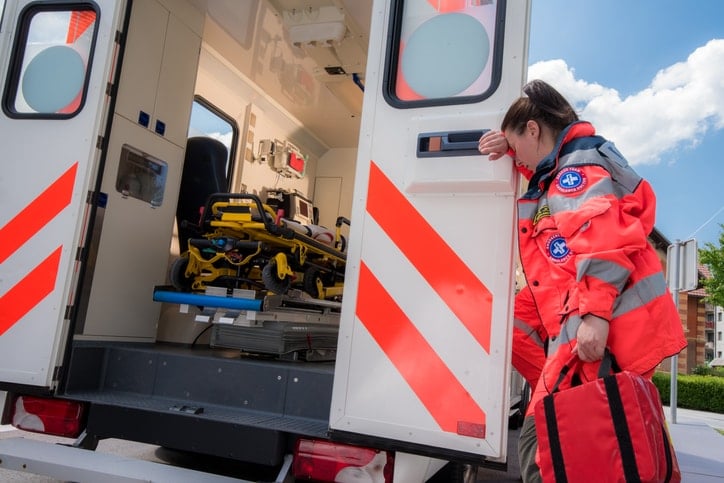Neprilysin and Heart Failure
Heart failure (HF) is a debilitating syndrome characterized by symptoms of fluid overload and dyspnea.9 It can be categorized as heart failure with reduced ejection fraction (HFrEF) or preserved ejection fraction (HFpEF).8 HFrEF is defined as left ventricular dysfunction as demonstrated by a left ventricular ejection fraction (LVEF) of < 40%.8 During acute phases of decompensation, compensatory mechanisms are active in an attempt to maintain cardiac output and preserve organ perfusion. Although HF increases the risk of death, nonfatal worsening of symptoms is the most common problem encountered by patients, who experience progressive impairment of functional capacity and quality of life.4 Nonfatal worsening may require intensification of oral medications or can necessitate emergent treatment, including hospitalization, intensive care, or expensive medical or surgical interventions.5 Two pivotal compensatory mechanisms are the sympathetic nervous system and the renin-angiotensin-aldosterone system (RAAS); these are responsible for many of the symptoms experienced by patients, including fluid overload, dyspnea and tachycardia.9
Historically, the treatment of HF was to prescribe an angiotensin converting enzyme inhibitor (ACEi), or an angiotensin receptor blocker (ARB). An ACEi had traditionally been used first and exchanged for an ARB if the patient had the inconvenient side effect of a dry, hacking cough, or the dangerous side effect of angioedema. A third drug was developed to treat HF that combined the benefits of an ARB without the side effects of an ACEi, along with the action of inhibiting the membrane-bound enzyme neprilysin.
Renin-Angiotensin-Aldosterone System (RAAS)
Renin is produced and stored in the kidneys and is the first component of the RAAS. Renin is secreted by the kidney in response to one or all of the following conditions:
- Decrease in arterial blood pressure
- Decreased serum sodium levels
- Stimulation of the sympathetic nervous system (SNS)
Angiotensinogen is produced and stored in the liver and is converted to angiotensin I in the presence of renin. Angiotensin I is a fairly inert decapeptide that is converted to angiotensin II when exposed to an angiotensin converting enzyme (ACE) found mostly in the lungs. Angiotensin II is an active pressor substance that increases vasopressin production, vasoconstricts the arteries and veins, and increases aldosterone secretion from the renal cortex. Increased aldosterone levels promote natriuresis and increased circulating volume through decreased diuresis.
ACE also inactivates the vasodilator peptide, bradykinin, which contributes to its pressor action, also giving the enzyme its alternate name kininase II.3 Bradykinins are peptides that cause vasculature dilation.
Angiotensin Converting Enzyme Inhibitor (ACEi)
With the administration of an ACEi, bradykinin levels are elevated, along with an increase in plasma and urinary prostaglandins, which are also vasodilators.3 The effect of lowering blood pressure through the vasodilatory act of bradykinin and prostaglandins makes ACEi a first-line therapeutic treatment for heart failure.
A negative side-effect of elevated bradykinin and prostaglandins is an annoying dry cough. This occurs in 10%-15% of patients being treated with an ACEi.3 A life-threatening upper airway obstruction named angioedema that occurs in 0.1%-0.2% of Caucasians and larger percentages in African Americans is also the result of increased bradykinin and prostaglandins.3
Angiotensin Receptor Blocker (ARB)
The actions of angiotensin II are mediated by two angiotensin (AT) receptors—AT1, which exerts the detrimental effects, and AT2, which triggers some beneficial effects.11 Angiotensin receptor blockers (ARBs) were developed with the rationale that angiotensin II production continues in the presence of ACE inhibition, driven through alternative enzyme pathways.13 ARBs primarily work by blocking angiotensin II at the AT1 receptor. By directly blocking this receptor, all angiotensin II is inhibited, and this allows the beneficial effects of AT2 receptor activation to dominate.10 The effect of angiotensin II blockade is similar to ACE inhibition and includes reduction in preload and afterload, as well as delaying the progression of ventricular dysfunction as mediated by hypertrophy and dilation.9
Similar to ACEis, ARBs are potent antihypertensive agents and are indicated as both first-line drugs in both hypertension and HFrEF (heart failure with reduced ejection fraction).3 However, a major difference between ACEis and ARBs is the greater specificity of the latter.3 Because ARBs do not block the degradation of kinins, angioedema and persistent cough are quite uncommon with their use.3
Natriuretic Peptides
Atrial natriuretic peptide (ANP), brain natriuretic peptide (BNP), and C-type natriuretic peptide (CNP) are members of the natriuretic peptide family responsible for body fluid homeostasis and blood pressure control. These three peptides form the natriuretic peptide system (NPS).
Distention of the atria and ventricles, as occurs in cardiac injury and/or overload, ventricular dysfunction, and HF, results in significant increases in the expression of ANP and BNP.3 The concentrations of circulating BNP and of its inactive precursor, N-terminal fragment of the pro-B-type natriuretic peptide (NT-proBNP), have become extremely valuable in the recognition of hemodynamic overload, ventricular dysfunction, and HF.6 Measurements of these peptides are also useful in assessing prognosis and monitoring therapy, and appears to be therapeutic targets as well.12
Neprilysin (NEP)
Neprilysin (NEP) catalyzes the degradation of several vasodilator peptides, including natriuretic peptides (ANP/BNP), angiotensin II, bradykinin, substance P, adrenomedullin, and endothelin-1.2 Therefore, inhibiting NEP (NEPi) will augment the naturally occurring natriuretic peptides, which promote natriuresis, induce vasodilation, and reduce cardiac hypertrophy and fibrosis.2 NEPi also increases the amount of the circulating vasopressors angiotensin II and endothelin I.7 These two opposing actions—inhibition of degradation of both vasoconstrictor and vasodilator peptides—neutralize each other and, as a consequence, NEPis alone have little effect on blood pressure or HF.1
Drugs were developed that would inhibit both ACE and NEP (duel inhibitors). The duel inhibitor was referred to as a vasopeptidase inhibitor and would be called angiotensin receptor-neprilysin inhibitors.
Angiotensin Receptor-Neprilysin Inhibitor (ARNI)
ARNIs combine both effective actions of decreasing the RAAS and inhibiting NEP. Because ACEi have the unwanted effect of bradykinin degradation with its accompanying cough and possible angioedema, an ARB was used in combination with a NEPi to produce an ARNI.
The introduction of an angiotensin receptor–neprilysin inhibitor (ARNI) (valsartan/sacubitril) and a sinoatrial node modulator (ivabradine), when applied judiciously, complements established pharmacological and device based therapies and represents a milestone in the evolution of care for patients with HF. 13
References
- Ando S, Rahman MA, Butler GC, et al. Comparison of candoxatril and atrial natriuretic factor in healthy men. Effects on hemodynamics, sympathetic activity, heart rate variability, and endothelin. Hypertension. 1995,26:1160–6.
- Bayes-Genis A, et al. Soluble neprilysin is predictive of cardiovascular death and heart failure hospitalization in heart failure patients. Journal of the American College of Cardiology. 2015;65(7), 657-665.
- Braunwald E. The path to an angiotensin receptor blocker antagonist-neprilysin inhibitor in the treatment of heart failure. Journal of the American College of Cardiology. 2015;65(10), 1029-1041.
- Butler J, Braunwald E, Gheorghiade M. Recognizing worsening chronic heart failure as an entity and an end point in clinical trials. JAMA. 2014;312:789–790.
- Cleland JG. How to assess new treatments for the management of heart failure: composite scoring systems to assess the patients’ clinical journey. Eur J Heart Fail. 2002;4:243–247.
- Gaggin HK, Januzzi JL Jr. Biomarkers and diagnostics in heart failure. Biochim Biophys Acta. 2013;1832:2442–50.
- McDowell G, Coutie W, Shaw C, et al. The effect of the neutral endopeptidase inhibitor drug, candoxatril, on circulating levels of two of the most potent vasoactive peptides. Br J Clin Pharmacol. 1997;43:329–32.
- McMurray JJ, Adamopoulos S, Anker SD, et al. ESC guidelines for the diagnosis and treatment of acute and chronic heart failure 2012. Eur Heart J. 2012;33:1787–847. doi: 10.1093/ eurheartj/ehs104.
- O’Donovan K. Angiotensin receptor blockers as an alternative in heart failure. Nurse Prescribing. 2014;12(8),393-399.
- Pitt B, Poole-Wilson PA, Segal R, et al. Effect of losartan compared with captopril on mortality in patients with symptomatic heart failure: randomized trial – the Losartan Heart Failure Survival Study Elite II. Lancet. 2000;355:1582–7.
- Scow DT, Smith EG, Shaughnessy AF. Combination therapy with ACE inhibitors and angiotensin receptor blockers in heart failure. Am Fam Physician. 2003;68(9):1795–8.
- Troughton RW, Frampton CM, Brunner-La Rocca HP, et al. Effect of B-type natriuretic peptide guided treatment of chronic heart failure on total mortality and hospitalization: an individual patient meta-analysis. Eur Heart J. 2014;35:1559–67.
- Yancy CW, Jessup M, Bozkurt B, Butler J, Casey DE Jr, Colvin MM, Drazner MH, Filippatos G, Fonarow GC, Givertz MM, Hollenberg SM, Lindenfeld J, Masoudi FA, McBride PE, Peterson PN, Stevenson LW, Westlake C. 2016 ACC/AHA/HFSA focused update on new pharmacological therapy for heart failure: an update of the 2013 ACCF/AHA guideline for the management of heart failure: a report of the American College of Cardiology/American Heart Association Task Force on Clinical Practice Guidelines and the Heart Failure Society of America. Circulation. 2016;134:e282–e293. DOI: 10.1161/CIR.0000000000000435.


